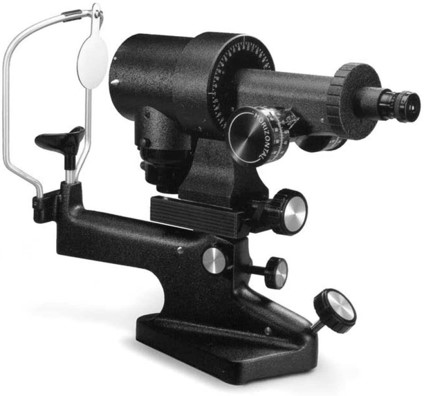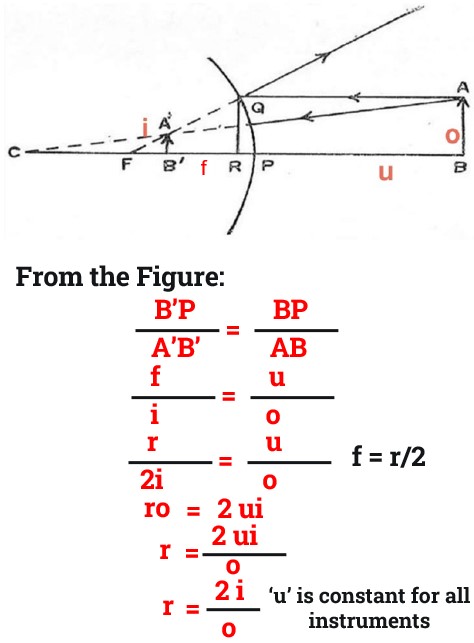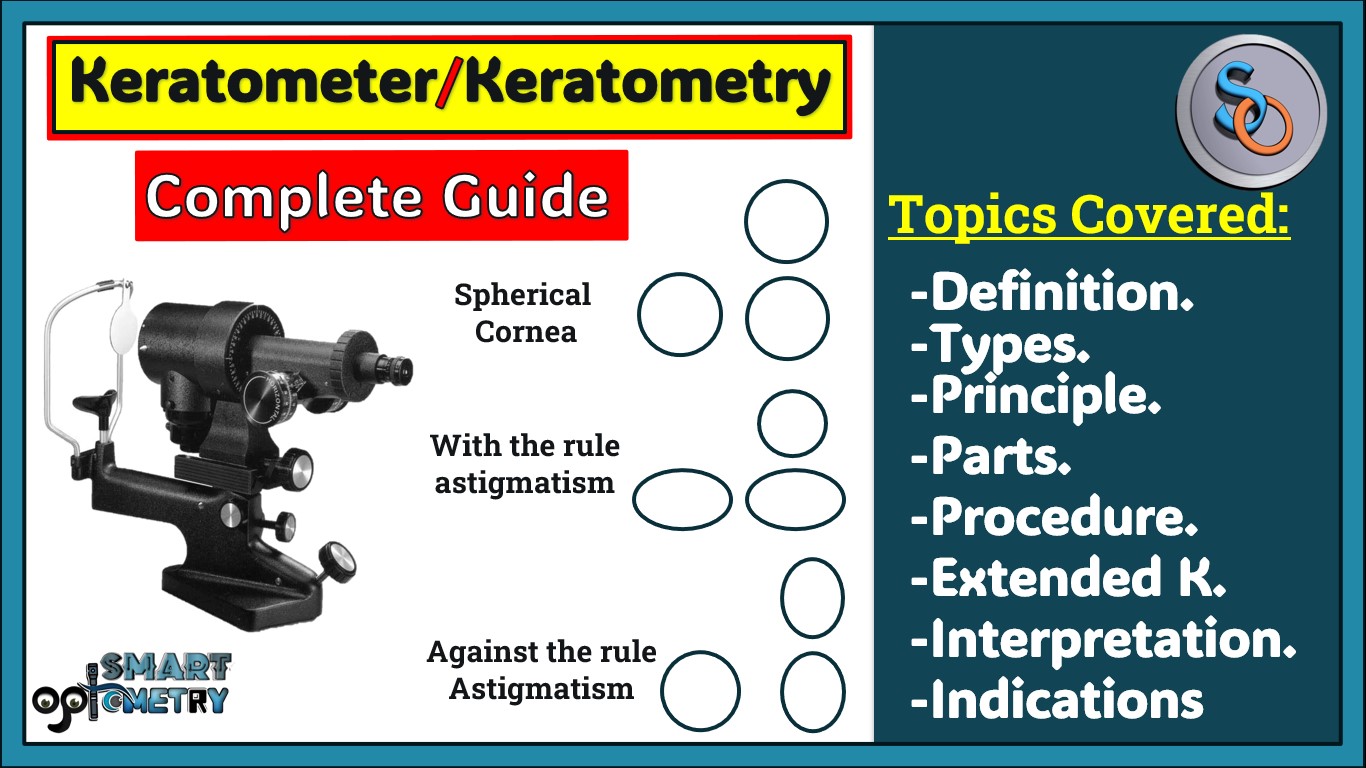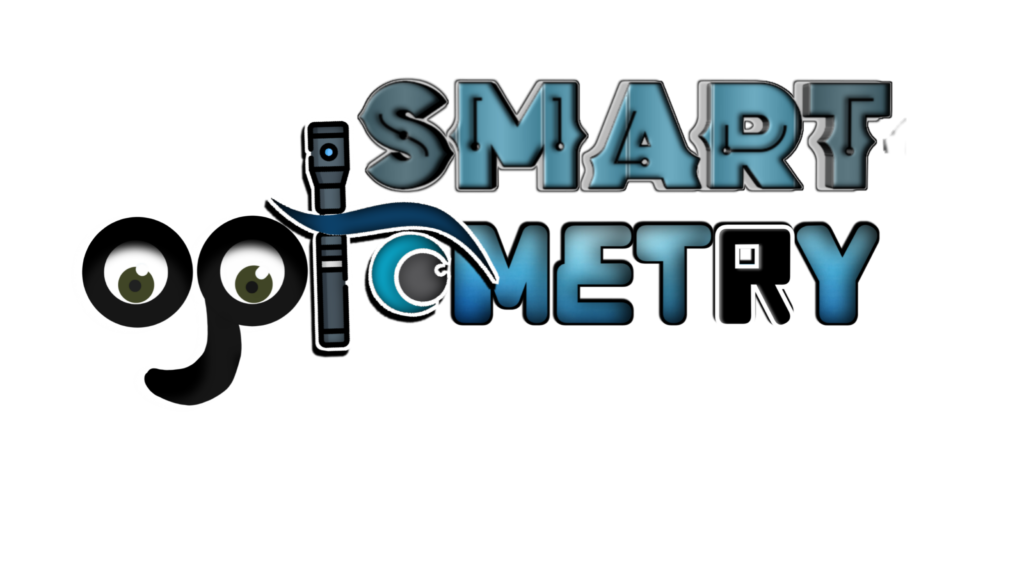Table of Contents
What is Keratometer?

A keratometer is an optical instrument designed for measuring the curvature of the anterior surface of the cornea, specifically across a fixed chord length typically ranging from 2 to 3 millimeters. The term “keratometry” is derived from “kerato,” referring to the cornea, and “metry,” indicating measurement.
Principle of Keratometer:

- Keratometer identify curvature of cornea based on the 1st purkinje image formed by anterior surface of the cornea.
- From the size of the image (1st purkinje image) formed by the anterior Cornea, radius of curvature of anterior Cornea can be calculated using the formula: r = 2i/o.
- Then, dioptric power of anterior Cornea is detected by using the formula: D = N1 -N2/r.
- Let’s see details mechanism of how Keratometer identify corneal curvature & corneal Power:
1. Reflection from Anterior Cornea:
- Despite being transparent, the anterior cornea reflects a small portion of incident light rays.
- This reflection occurs due to the difference in refractive indices between the cornea and the surrounding media.
- Consequently, the cornea behaves like a convex mirror, forming an image of objects.
2. Relationship between Curvature and Image Size:
- The curvature of the cornea influences the size of the image formed by the reflected light rays.
- As the curvature increases, the size of the image decreases, and vice versa.
- This relationship between curvature and image size serves as the basis for corneal curvature measurement using a keratometer.
3. Calculation of Radius of Curvature:
- The radius of curvature of the anterior cornea can be calculated using the formula r = 2i/o
Here
- r = Represents the radius of curvature of cornea.
- i = Denotes the size of the image formed by the cornea.
- o = Represents the size of the object projected by keratometer.
4. Determination of Dioptric Power:
- Once the radius of curvature is known, the dioptric power of the anterior cornea can be calculated using the formula: D = N1 -N2/r,
Here,
- D = Represents the dioptric power,
- N1 = is the refractive index of the keratometer (1.3375),
- N2 = is the refractive index of air (1.000), and
- r = is the radius of curvature obtained from the previous step.
So,
- D = (1.33375 – 1.00) X 1000/r (Multiply by 1000 to find the answer in Dioptric value)
- D = 0.3375 X 1000/r
- D = 337.5/r
Thus, Dioptric value of cornea can be easily identify dividing 337.5 by the radius of curvature or cornea (r).
Types of Keratometer:
- There are two main types of keratometers, each with distinct characteristics and methods of operation:
- a. Manual Keratometer:
- b. Automated Keratometer:
a. Manual Keratometer:
- In a manual keratometer, the corneal power is determined through the manual adjustment of mires by the examiner.
- This method requires the examiner to have specific skills to perform the test accurately.
- There are two subtypes of manual keratometers:
- One Position Manual Keratometer.
- Two Position Manual Keratometer.
One Position:
- This type allows for the measurement of both horizontal and vertical meridians while keeping the keratometer in the same position.
- An example of this type is the Bausch & Lomb Keratometer.
Two Position:
- With this type, the keratometer needs to be repositioned after measuring one meridian to measure another.
- An example is the Javal & Schiotz Keratometer.
b. Automated Keratometer:
- An automated keratometer automatically measures corneal power, eliminating the need for manual adjustment by the examiner.
- This type offers high accuracy and ease of use.
- Examples of automated keratometers include the Humphrey autokeratometer and the Canon Autokeratometer.
- Additionally, when an autorefractometer and keratometer are combined into a single instrument, it is referred to as an Auto Kerato-refractometer.
Procedure of Manual Keratometry:
- The procedure of using a keratometer involves several steps to ensure accurate measurements. Here’s a precise explanation based on the provided information:
1. Instrument Calibration:
- Begin by calibrating the keratometer using a steel ball of known curvature.
- Match the keratometer reading with the known curvature of the steel ball to ensure accurate measurements.
2. Patient Preparation:
- Request the patient to sit comfortably, positioning their chin in the chin rest and resting their forehead in the headrest.
- Non testing eye should be occulded.
- Instruct the patient to keep the eyes wide open while blinking normally.
3. Focusing Mires:
- For the horizontal meridian, adjust the horizontal knob until the plus (+) signs of the central and left images are superimposed.
- For the vertical meridian, adjust the vertical knob until the minus (-) signs of the central and upper images are superimposed.
- If astigmatism is present, the plus (+) or minus (-) signs may not initially be superimposed. In such cases, rotate the instrument until they are aligned properly.
Interpretation of Manual Keratometry:

- Interpretation of manual keratometry involves assessing the shape and power of the cornea based on the appearance of the mires.
1. Spherical Cornea:
- When the cornea is spherical, there is no difference in power between the two meridians.
- The mires are observed as perfectly circular or spherical, indicating uniform curvature across the cornea.
2. Astigmatism:
- Astigmatism is characterized by a difference in power between the two meridians of the cornea.
- In “With the rule astigmatism,” the mires appear horizontally oval, indicating greater curvature in the vertical meridian.
- Conversely, in “Against the rule astigmatism,” the mires appear vertically oval, indicating greater curvature in the horizontal meridian.
3. Irregular Cornea (Keratoconus):
- In cases of irregular cornea, such as keratoconus, the shape of the mires will be irregular rather than perfectly spherical.
- The irregularity in mire shape suggests an uneven or distorted corneal surface, characteristic of conditions like keratoconus.
Extended Keratometer:
- Extended keratometry expands the measurement range of a manual keratometer beyond its standard range of 36D to 52D.
- Here’s a precise explanation of how extended keratometry works:
Standard Range:
- A manual keratometer typically measures corneal power in the range of 36D to 52D without additional lenses.
Extension for Higher Powers:
- If the corneal power in any meridian exceeds 52D, an extra lens is added to the keratometer to extend its range.
- A +1.25D lens is placed over the eyepiece, allowing measurement up to 61D.
- The final keratometry (K) reading is adjusted by multiplying it by 1.185 after placing the +1.25D lens.
Example Calculation for Higher Powers:
- If the K reading after adding the +1.25D lens is 48D, the final corneal power is calculated as 48 * 1.185 = 56.88D.
Extension for Lower Powers:
- Similarly, if the corneal power in any meridian is less than 36D, a -1.00D lens is added to the keratometer.
- This allows measurement down to 30D.
- The final K reading is adjusted by multiplying it by 0.840 after placing the -1.00D lens.
Example Calculation for Lower Powers:
- If the K reading after adding the -1.00D lens is 36D, the final corneal power is calculated as 36 * 0.840 = 30.24D.
Indication of Keratometry:
- Keratometry serves various indications in ophthalmic practice, offering valuable insights into corneal characteristics and aiding in diagnostic and treatment decisions.
1. Estimate Radius of Curvature & Dioptric Power of Anterior Cornea**:
- Keratometry enables the estimation of the radius of curvature and dioptric power of the anterior cornea, providing essential information for refractive assessment and contact lens fitting.
2. Measurement of Corneal Astigmatism:
- If different between K1 & K2 is equal to cylinder power revealed in retinoscopy or autorefractometer then its corneal astigmatism.
- If cylinder power revealed in retinoscopy or autorefractometer is more than the difference in K1 & K2 then its internal (Lenticular or retinal) astigmatism.
3. Detection of Irregular Astigmatism:
- Keratometry aids in identifying irregular astigmatism by observing distorted mires in multiple directions, contrasting with the uniform oval pattern seen in regular astigmatism.
4. Detection of Progressive Myopia:
- Keratometry can detect progressive myopia by monitoring changes in K1 and K2 values over time, with increasing values indicating curvature myopia progression.
5. IOL Power Calculation:
- K1 and K2 values play a crucial role in calculating intraocular lens (IOL) power, serving as important parameters alongside axial length for accurate IOL selection in cataract surgery.
6. Pre- & Post-Surgical Astigmatism:
- Keratometry assists in evaluating pre-existing astigmatism and monitoring post-surgical astigmatic changes, guiding treatment planning and follow-up care.
7. Non-Contact Tear Film Breakup Time Test:
- Fluorescein dye is applied, and patient is asked to not blink.
- With the break of tear film mires get distorted which is break point.
- Break point less 10sec is considered dry eye suspect.
- Check Our Courses: Ophthalmic Instrumentation, Clinical Refraction, Contact Lens, Binocular Vision, Dispensing Optics, MCQs in Optometry
- Download our App “Optometry Notes & MCQs” from Google Play Store.




